Search results for: 'den'
-
 Egyptian funerary figurine for Nefer-hotep
Egyptian funerary figurine for Nefer-hotepInteresting ushabti from Memphis dating to the late 19th Dynasty, New Kingdom. The owner was an official from the Temple of Ptah.
Price: on request Massive Bronze Age spear head, possibly celtic
Massive Bronze Age spear head, possibly celticPerfectly preserved, large piece with beautiful patina. From an old German collection.
Price: on request Egyptian ushepti of Pasinebu
Egyptian ushepti of PasinebuTotenfigur für Pasinebu, geboren der Setjet, mit T-förmiger hieroglyphischer Inschrift. 26. bis 30. Dynastie, Spätzeit des Alten Ägyptens. Sehr gute Erhaltung mit klar erkennbaren Hieroglyphen.
Price: on request Ägyptischer Uschebti des Pasinebu
Ägyptischer Uschebti des PasinebuTotenfigur für Pasinebu, geboren der Setjet, mit T-förmiger hieroglyphischer Inschrift. 26. bis 30. Dynastie, Spätzeit des Alten Ägyptens. Perfekte Erhaltung mit klar erkennbaren Hieroglyphen.
Price: on request Cylinder Seal from the late Uruk period
Cylinder Seal from the late Uruk periodSmall seal made of appealing igneous rock. The engraved wave pattern is typical for the late Uruk period of Mesopotamia.
Price: on request Scarab with magic formula
Scarab with magic formulaThe stamp shows the anra formula in a cartouche. The amulet should thus serve a magic or ritual purpose for its owner.
Price: on request Roman discus fibula with color glass paste
Roman discus fibula with color glass pasteSpannende Fibel mit Sterndekor und Glaspaste. Eine Weiterentwicklung keltischen Kunsthandwerks in der Zeit römischer Herrschaft. Gut dokumentierter Typ aus dem 2. Jh. v. Chr. mit Verbreitung in weiten Teilen Europas.
Price: on request Scarab with pattern of circles
Scarab with pattern of circlesThe beetle stone bears a popular motive of the Middle Empire. A nice example of its kind. This scarab is described in the catalogue of Irène Gautier-Vodoz.
Price: on request Cowroid with decorated body
Cowroid with decorated bodyThe cowroid has an interesting decoration across the upper surface. The lower surface is inscribed with hieroglyphs. This cowroid is discussed in the catalogue of Gautier-Vodoz.
Price: on request Ägyptischer Uschepti mit rückseitigen Hieroglyphen
Ägyptischer Uschepti mit rückseitigen HieroglyphenÄgyptische Totenfigur. Rückseitige Hieroglyphen. Mintgrüne Fayence. Spätzeit bis Beginn ptolemäische Zeit, 664 v. Chr. - 300 v. Chr.
Price: on request Roman oil lamp with kissing lovers in mirror - parallel in a museum
Roman oil lamp with kissing lovers in mirror - parallel in a museumFrom the collection of Mr. Voigtmann, who had used the lamp. Moving relief in mirror, rare, possibly one of the rare original gallic motifs.
Price: on request Cylinder seal with god of the moon and inscription
Cylinder seal with god of the moon and inscriptionCylindrical seal with religious scene and inscription from the Third Dynasty of Ur. A worshipper is lead to the god of the moon Sin.
Price: on request Beautiful Roman glass bottle
Beautiful Roman glass bottleBeeindruckendes Fläschchen aus der römischen Zeit. Seinerzeit vermutlich für Parfüm oder kostbare Duftöle verwendet. Das Glas schimmert durch starke Irideszenz in allen Farben. Wunderschönes Exemplar!
Price: on request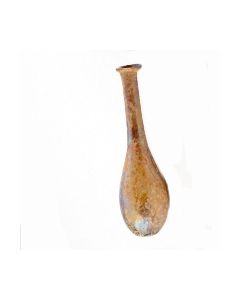 Römischer Flakon mit wunderschöner Irideszenz
Römischer Flakon mit wunderschöner IrideszenzBeeindruckendes Glasfläschchen aus der römischen Zeit. Seinerzeit vermutlich für Parfüm oder kostbare Duftöle verwendet. Die feine Patina schimmert in zahlreichen Farben. Prachtexemplar!
Price: on request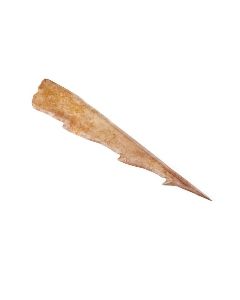 Harpoon of the Maglemosian culture
Harpoon of the Maglemosian cultureFine craftsmanship hunting weapon. Important evidence of the beginnings of fishing in Northern Europe. Mesolithic, 9000 to 6500 BC.
Price: on request Roman intaglio with Hermes
Roman intaglio with HermesThe engraved glass dates back to the Roman Republic. It shows the Greek god of the travel and trade. He is holding a purse and cloak in his hands.
Price: on request Egyptian New Year flask with ornamentation
Egyptian New Year flask with ornamentationHieroglyphic inscription expressing New Year wishes for Ptah at the beginning of the nile floodings. Important 26th dynasty piece associated with the Egyptian New Year rituals. The object is a fantastic example of the skilled workmanship and artistic quality of faience in ancient Egypt.
Price: on request Ägyptisches Papyrusamulett
Ägyptisches PapyrusamulettPapyrusamulett aus mintgrüner Fayence, symbolisch für Jugend und Gedeien. Spätzeit des Alten Ägyptens, 664 bis 332 v. Chr.
Price: on request Roman knee brooch
Roman knee broochPrime example of this important and popular type of brooch during the 2nd century.
Price: on request Ägyptischer Uschebti mit rückseitigen Hieroglyphen
Ägyptischer Uschebti mit rückseitigen HieroglyphenÄgyptische Totenfigur. Rückseitige Hieroglyphen. Mintgrüne Fayence. Spätzeit bis Beginn ptolemäische Zeit, 664 v. Chr. bis 300 v. Chr.
Price: on request Roman bronze Minerva figurine
Roman bronze Minerva figurineNicely preserved example of Roman provincial art.
Price: on request Griechisch-römische Goldohrringe
Griechisch-römische GoldohrringeDie griechisch-römischen Ohrringe besitzen kunstvolle Granularien. Das Paar ist mehrfach publiziert.
Price: on request Ägyptische Totenfigur aus der 30. Dynastie
Ägyptische Totenfigur aus der 30. DynastieUschebti aus mintgrüner Fayence. Typischer Bart und dreigeteilte Perrücke. Die Totenfigur datiert in ihrer einfachen Form aus der Spätzeit des Alten Ägyptens.
Price: on request Clay idol from Syria
Clay idol from SyriaFemale figurine from Bronze Age Syria, 3rd to beginning of 2nd millenium BC. With characteristic bird shaped head.
Price: on request Two Roman jugs from the Rhineland
Two Roman jugs from the RhinelandFound 1966 till 1981 near the Roman city of Novaesium, today's Neuss in Germany. Novaesium was an early Roman foundation and with this is one of the oldest cities in Germany.
Price: on request Two small Roman pots from the Rhineland
Two small Roman pots from the RhinelandTwo small Roman pots from the Rhineland
Price: on request Hand axe from Galilee
Hand axe from GalileeBig paleolithic hand axe. The universal stone age tool could be use as a borer or cutting tool. Around 500,000 to 200,000 BC.
Price: on request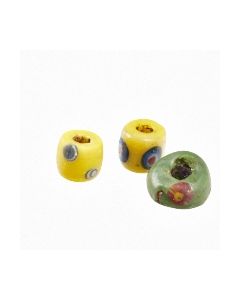 Roman eye beads
Roman eye beadsGroup of miniature artworks made of mosaic glass. The Roman eye beads are from early Imperial times.
Price: on request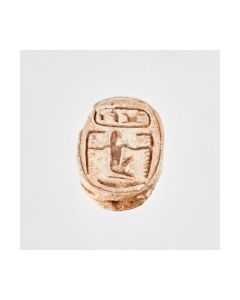 Scarab with god Heh and cartouche
Scarab with god Heh and cartoucheInteresting motive showing the kneeling god of endlessness with palm stem in both hands. Above him the cartouche of pharao Mencheperre. Around the 18th dynasty of ancient Egypt.
Price: on request Hittite beak-spouted ewer
Hittite beak-spouted ewerImposing vessel with well preserved paint. It shows geometric figures and sun wheel. From the 2nd millenium BC.
Price: on request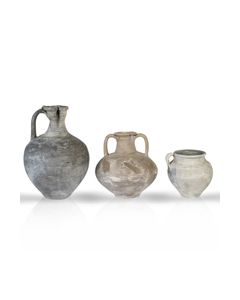 Three Roman pottery vessels from the Rhineland
Three Roman pottery vessels from the RhinelandFound 1966 till 1981 near the Roman city of Novaesium, today's Neuss in Germany. Novaesium was an early Roman foundation and with this is one of the oldest cities in Germany.
Price: on request Three Roman pottery vessels from the Rhineland
Three Roman pottery vessels from the RhinelandFound 1966 till 1981 near the Roman city of Novaesium, today's Neuss in Germany. Novaesium was an early Roman foundation and with this is one of the oldest cities in Germany.
Price: on request Egyptian ushabti from the Third Intermediate Period
Egyptian ushabti from the Third Intermediate PeriodFunerary statuette of faience with black paint. The opposed hands might indicate Tanis as origin. Third Intermediate Period of Ancient Egypt.
Price: on request Egyptian shabti
Egyptian shabtiFunerary statuette of faience. The opposed hands might indicate Tanis as origin. Third Intermediate Period of Ancient Egypt.
Price: on request Egyptian ushabti for Ra-mes
Egyptian ushabti for Ra-mesThe mummiform funerary figurine dates to the Late Period of ancient Egypt, 26th to 31st dynasty. It is remarkable that it probably originates from the burial of two brothers, Ra-mes and Somtus-tefnacht.
Price: on request Ushabti for Ra-mes
Ushabti for Ra-mesThe mummiform funerary figurine dates to the Late Period of ancient Egypt, 26th to 31st dynasty. It is remarkable that it probably originates from the burial of two brothers, Ra-mes and Somtus-tefnacht.
Price: on request

